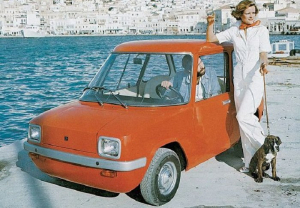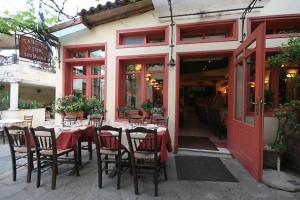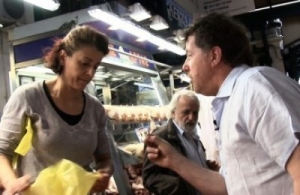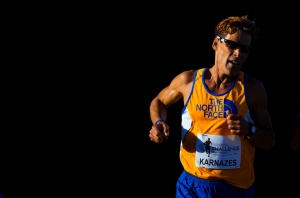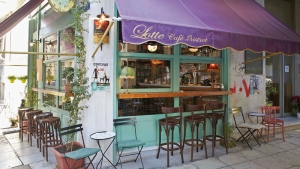Trekking through challenging terrains across the globe, enduring hours of arduous running in hundreds of marathons, breaking numerous athletic records, and constantly pushing his personal limits, Dean Karnazes has rightfully earned his title as the Ultra Marathon Man. Beyond long distance endurance running, the Greek-American athlete also enjoys competing in triathlons, is a successful entrepreneur, best-selling author, philanthropist, and dedicated father.
In 2013, Karnazes took on another title as the official ambassador of the annual Navarino Challenge, which takes place in Arcadia and Messinia, Greece. The three-day sporting event brings together a diverse range of participants in an effort to raise awareness on the issue of childhood obesity, while promoting the benefits of the mediterranean diet. Karnazes speaks with
Portes Magazine about the upcoming
Navarino Challenge, to take place September 11 through 13, and offers some insight on his athletic career.
What is unique about the Navarino Challenge as a sporting event?To me it’s a very progressive event, and I’ve done hundreds of different types of running events across the globe. For Greece, this an event that is ahead of its time, and it’s an event conceived for mass participation. The core concept is similar to the original notion of the Ancient Olympics, which served to bring all of the citizenry out in a celebration of fitness and health. The [Ancient Olympics] were not only for elite athletes vying to win a gold medal. All of the participants received a laurel or a Greek wreath, so to me the Navarino Challenge is approachable to anyone regardless if you were an elite runner used to running great distances, or just someone who is going to run their very first challenge. And that’s something that appealed to me from the very beginning, making sure the challenge is not so intimidating so that many people are welcome and encouraged to take part.
How would you compare this sporting challenge to past events or courses in which you have participated?I don’t know why, but there is something magical about the Navarino Challenge. I think in part people are inspired by me because they think, well here is a guy who runs hundreds of kilometers at a time and he’s out here running a more casual 10 kilometers with me. I think that inspires people, but I think people fail to recognize how much I’m inspired by seeing people who are pushing themselves to their very limit. For me, going out and running a half marathon is not extraordinary, and while it doesn’t necessarily come easy to me it’s less difficult for me than for others. But in this event, people really rise to the occasion and prove to themselves that they are better than they think they are and can go further than they thought they were able.
As the ambassador of the Navarino Challenge, what advice would you give to someone who is participating in a marathon or athletic endurance event for the first time?Start from the ground up and invest in a good pair of shoes. Then I would say try starting your training program by running a set number of minutes instead of a set number of feet or miles. When you first start out you might just say I’ll commit to running just five minutes straight while pacing yourself, and then work up that way and try to expand that to ten or fifteen minutes as days go by. You’ll find that’s much easier than setting mile goals and much simpler in terms of keeping track of your goal.
You referenced earlier the concept of the Ancient Olympics is reflected in the Navarino Challenge. Can you share with us what ancient Greek wisdom or ideal you think might still apply to athletes and athleticism today?The Greek ideal of ‘arete’ suggests goodness comes from finding a perfect balance of the mind, body, and spirit. And I think in the Western world unfortunately we have really neglected our body. I mean the Greeks embraced physicality and the balance between mind and body as being important. For example, in Ancient Greece gymnasiums were not only a place of mental learning, but also physical learning, and I really embrace that idea, because when your body is sharp your mind is sharp, and that’s a very ancient kind of notion that the Greeks honored. Other things the ancient Greeks taught us was to dare, to question everything and to go beyond what you think are your limitations. As they used to say “he who dares wins” so in practice I try to be fearless and explore new things, and not be afraid to fail.
In your athletic career, you have participated in countless running challenges across the world. If you had to choose, what would be your ideal natural terrain to run in?I really enjoy running around Greece. I know it sounds funny to say but it almost feels like a homecoming to me. When I run around Athens, and especially when I run around Messinia, Arcadia, or Laconia or some of the more rural areas, you don’t often see people running down the street. And I can’t tell you how many people stop and just ask me if I want some food or if I want a ride, or they just congratulate me, and it’s really magical to see that you can break through to people in that way. If you think about it, it’s kind of a foreign thing for them to be driving down a road that they’ve been driving down for 20 or 30 years and all of a sudden they see some guy running, and he’s healthy and enjoying it and he’s Greek. I’ve run on all seven continents twice and I’ve run in some of the most exotic and beautiful places in the world, and still running in Greece to me has a certain magic that nowhere else does.
To read this interview in full, please visit:
Portes Magazine

